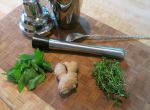 In case it isn’t obvious, we tend to obsess with how drinks are assembled, and whether or not using one technique over another makes for a better drink. One such technique is muddling. In particular we were wondering if muddling an ingredient dry (in the shaker alone) vs. wet (in combination with the spirit) makes a difference.
In case it isn’t obvious, we tend to obsess with how drinks are assembled, and whether or not using one technique over another makes for a better drink. One such technique is muddling. In particular we were wondering if muddling an ingredient dry (in the shaker alone) vs. wet (in combination with the spirit) makes a difference.
It’s these kinds of things keep us up at night. Did we mention we tend to obsess about booze and cocktails? 🙂 Read on to see if there’s a preferred muddling technique or not.
First up, we decided to add thyme to a Gimlet. Thyme is a favorite herb for both of us, and we thought it might go nicely with gin and lime. Turns out we were right. Plus, we’re trying to stick with simpler drinks in this post, so it is easier to compare the results of the muddling.
- 2 1/2 oz gin
- 1/2 oz lime juice
- 1/4 oz simple syrup
- Several sprigs of thyme. Remove leaves and discard the stems if stems are woody.
Muddle thyme wet or dry depending on your preference. Add remaining ingredients. Shake with ice. Double strain into a glass. Enjoy!
Dry
- Nose: Thyme, gin (juniper & black pepper), little bit of lime, both peel and juice.
- Palate: Interesting sweet, savory intro. Lightly sweet gin botanicals on the intro. Lime, thyme and dried lemon & orange peel on the mid-palate. Strong acidic lime and milder aromatic thyme from the mid-palate into the finish. Starts out lightly sweet and then drys out. A little cleaner and more citrusy when compared directly to the wet muddled version.
- Nose: Same as the dry muddled version, except the thyme is stronger. Compared side by side, the dry muddled has very minor thyme notes.
- Palate: Thyme is more integrated throughout the drink. Juniper and noticeable vegetal notes from the thyme on the intro. Thyme aromatics and lime peel on the mid-palate. Citrus-y gin notes on the finish. Interesting strong savory, almost loam-y note at the end of the intro. Christa likes it, Shaun finds it a bit off-putting.
- 2 oz white rum
- 1 oz lime juice
- 3/4 oz simple syrup
- 10 mint leaves
- 2 oz soda
Muddle mint leaves, wet or dry as you prefer. Add remaining ingredients except for soda and dry shake (no ice). Add soda to a glass. Strain other ingredients into glass. Add ice. Garnish with a sprig of mint.
Dry
- Nose: Vanilla, coconut, pineapple from the rum. Lime. Mint.
- Palate: On the open, sweet tropical notes from the rum followed by sweet mint. Sweet creamy lime (like key lime pie) on the mid-palate. Finish is bitter lime peel and more mint. More citrus-y overall when compared to the wet version, and the rum shines more.
Wet
- Nose: Same nose, but with more mint and lime peel. Rum doesn’t stand out quite as much.
- Palate: Way more mint. Sequence of flavors is the same, but with mint underpinning everything. Other flavors are more subdued. Tiny bit sweeter in comparison to the dry version.
- 2 oz scotch
- 3/4 oz lime juice
- thumbnail sized chunk of ginger, peeled
- 1 1/2 oz ginger beer
Muddle ginger wet or dry. Add remaining ingredients except for ginger beer. Shake with ice. Strain into a glass. Top with ginger beer.
Dry
- Nose: Lime, peat, malt, ginger. Little bit of salty caramel corn, like cracker jacks.
- Palate: Sweet ginger to start, along with malt, salty caramel and sherry. Big bite of ginger and bright sharp lime on the mid-palate. Gentle barrel wood and strong ginger on the finish. A lot sweeter compared to the wet muddled version.
Wet
- Nose: Like the dry version, but milder lime, more ginger, less scotch. No cracker jacks.
- Palate: Lots more ginger throughout, to the point of being overpowering. Little bit of malt to start, plus earthiness from the ginger which pairs well with the same flavors in the scotch. Mid-palate and into the finish, very strong ginger and more lime peel. Not as sweet as the dry version.
When we first conceived of this post, we figured we might be a little overly obsessive and that the difference between wet and dry muddling would probably be negligible. However, it’s clear that it makes quite a large difference, and which technique you prefer obviously depends on what you’re going for. In all three cases, wet muddling tended to draw out more flavor from the herb or spice. However, it can do so to the point of putting that flavor out of balance, and it can also draw out other unexpected secondary flavors. In some cases for the better, and in others not so much, depending on your palate. We suggest you experiment yourself and see which technique gives you the flavor profile you’re looking for.
Join us next week as we move into the fruits and vegetables category for our muddled experiment.
Filed under: gin, lime juice, rum, scotch, Tasting Notes Tagged: cragganmore scotch, gingered mamie taylor cocktail recipe, House Spirits Aviation gin, mojito cocktail recipe, prichards crystal rum, thyme gimlet cocktail recipe
![]()
SOURCE: Booze Nerds – Read entire story here.





